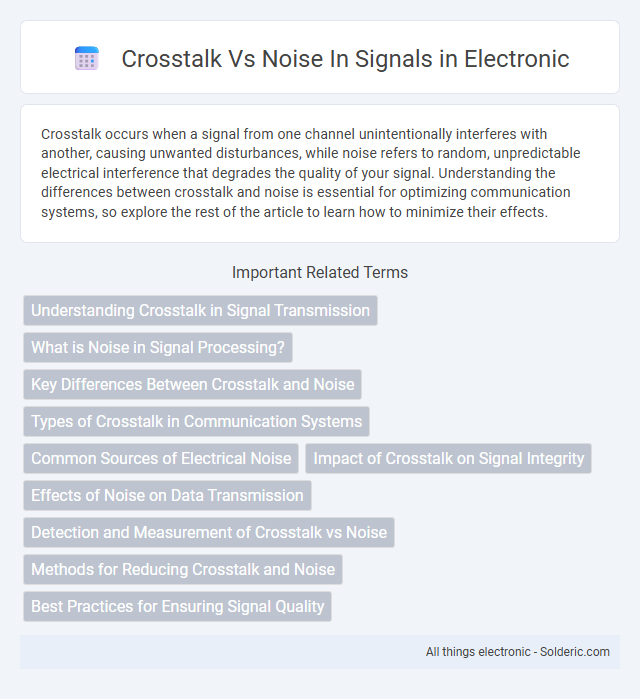Crosstalk occurs when a signal from one channel unintentionally interferes with another, causing unwanted disturbances, while noise refers to random, unpredictable electrical interference that degrades the quality of your signal. Understanding the differences between crosstalk and noise is essential for optimizing communication systems, so explore the rest of the article to learn how to minimize their effects.
Comparison Table
| Aspect | Crosstalk | Noise |
|---|---|---|
| Definition | Unwanted coupling of signals between adjacent communication channels | Random, unwanted electrical or electromagnetic interference affecting signal integrity |
| Source | Adjacent signal lines or circuits | External electromagnetic interference, thermal effects, or equipment |
| Effect on Signal | Interference causing signal overlap and data errors | Signal distortion, reduced signal-to-noise ratio, and data loss |
| Control Methods | Shielding, twisting cables, and spacing lines apart | Filtering, shielding, proper grounding, and error correction |
| Occurrence | Prominent in closely spaced parallel cables or PCB traces | Common in almost all electronic communication systems |
| Measurement | Measured as Near-End Crosstalk (NEXT) or Far-End Crosstalk (FEXT) in dB | Measured as Signal-to-Noise Ratio (SNR) or Noise Figure (NF) |
Understanding Crosstalk in Signal Transmission
Crosstalk in signal transmission occurs when unwanted electromagnetic interference from adjacent channels disrupts the original signal, leading to degradation in communication quality. This interference often results from poor cable shielding or improper circuit layout, causing signals to bleed into one another, which increases error rates and reduces overall system performance. Understanding crosstalk is crucial for optimizing your network design to minimize noise and ensure clear, reliable data transmission.
What is Noise in Signal Processing?
Noise in signal processing refers to any unwanted or random disturbances that degrade the quality of a signal, causing errors and reducing clarity. It originates from various sources including thermal fluctuations, electromagnetic interference, and quantization errors, resulting in signal distortion and loss of information. Unlike crosstalk, which is interference caused by unwanted coupling between adjacent signal lines, noise broadly encompasses all forms of random and unpredictable signal variations.
Key Differences Between Crosstalk and Noise
Crosstalk refers to the unintended coupling of signals between adjacent communication channels, often resulting in interference that mimics the original signal waveform, whereas noise encompasses random, unpredictable disturbances that degrade signal quality. Crosstalk predominantly affects multi-conductor systems such as twisted pair cables, while noise can originate from various external sources including electromagnetic interference, thermal agitation, and device imperfections. Understanding these distinctions is critical for designing effective signal integrity measures and ensuring reliable data transmission in electronic and telecommunication systems.
Types of Crosstalk in Communication Systems
Crosstalk in communication systems primarily manifests as Near-End Crosstalk (NEXT) and Far-End Crosstalk (FEXT), both of which degrade signal quality by introducing interference between adjacent channels. NEXT occurs when a transmitted signal from one pair of wires interferes with a receiver at the same end, while FEXT happens when interference is detected at the opposite end of the transmission line. Understanding and mitigating these types of crosstalk is essential for maintaining high data integrity and reducing error rates in wired communication systems such as Ethernet and DSL.
Common Sources of Electrical Noise
Common sources of electrical noise in signals include electromagnetic interference (EMI) from nearby power lines, radio frequency interference (RFI) from wireless devices, and thermal noise generated by the inherent resistance in electronic components. Crosstalk specifically arises from unwanted coupling between adjacent signal lines, causing signal distortion and degradation. Effective shielding, proper grounding, and careful cable routing minimize both crosstalk and other forms of electrical noise to maintain signal integrity.
Impact of Crosstalk on Signal Integrity
Crosstalk significantly degrades signal integrity by introducing unwanted electromagnetic interference between adjacent signal lines, causing data errors and reduced communication reliability. This interference results in signal distortion, increased bit error rates, and compromised system performance, particularly in high-speed digital circuits and densely packed electronic devices. Minimizing crosstalk through proper cable shielding, spacing, and layout design is essential to maintain clear signal transmission and ensure robust data integrity.
Effects of Noise on Data Transmission
Noise in data transmission degrades signal quality by introducing random variations that obscure the intended message, leading to increased bit error rates and reduced overall system reliability. Crosstalk, a specific type of noise caused by electromagnetic interference from adjacent signal lines, can particularly distort or corrupt digital data streams in high-speed networks. Your data integrity and communication speed are directly impacted by the noise level, necessitating effective shielding, filtering, and error correction techniques to maintain optimal performance.
Detection and Measurement of Crosstalk vs Noise
Detection and measurement of crosstalk and noise in signals involve analyzing signal integrity using specialized equipment like spectrum analyzers and oscilloscopes. Crosstalk is typically identified by its correlation with adjacent signal lines, while noise appears as random fluctuations uncorrelated with other signals. Your ability to accurately quantify these disturbances depends on techniques like time-domain reflectometry and signal-to-noise ratio calculations for precise diagnostics.
Methods for Reducing Crosstalk and Noise
Shielding cables with conductive materials and maintaining proper cable separation effectively reduce crosstalk and noise in signal transmission. Employing twisted pair cables and differential signaling enhances noise immunity by minimizing electromagnetic interference between adjacent wires. Implementing filters and grounding techniques further suppress unwanted noise, ensuring your signal integrity remains optimal.
Best Practices for Ensuring Signal Quality
Minimizing crosstalk and noise in signal transmission requires maintaining proper cable spacing and using shielded twisted pair (STP) cables to reduce electromagnetic interference (EMI). Implementing differential signaling and grounding techniques enhances noise immunity, while employing high-quality connectors and regularly testing with signal analyzers ensures optimal signal integrity. Adhering to industry standards such as ANSI/TIA-568 and IEEE 802.3 helps maintain consistent signal quality in data communication systems.
crosstalk vs noise in signals Infographic

 solderic.com
solderic.com